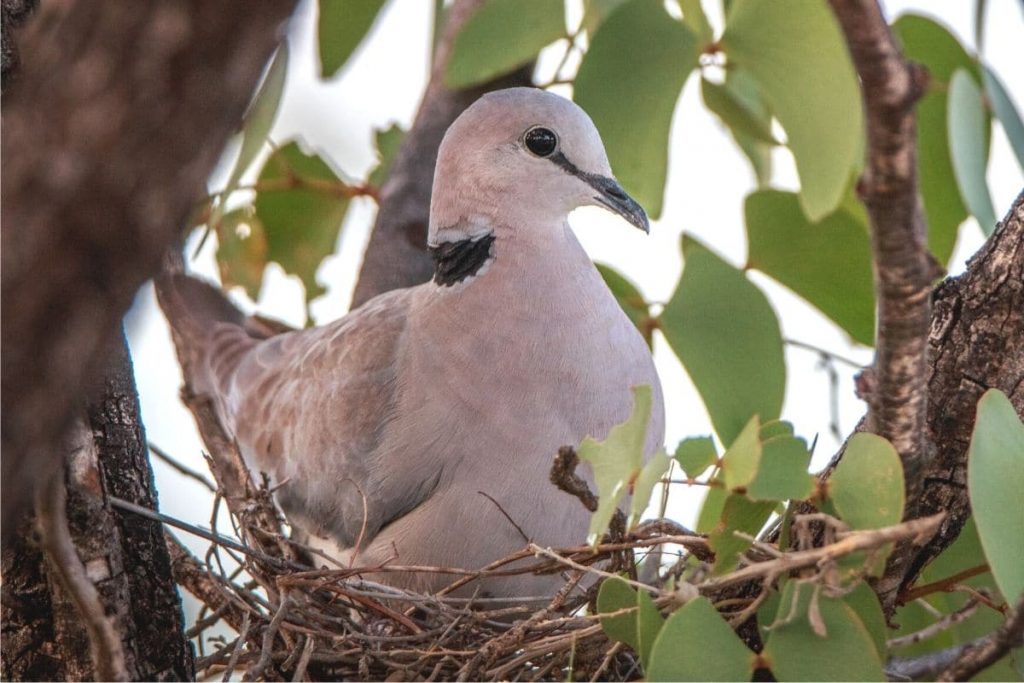Pigeons are graceful, loyal and particularly intelligent birds. On the balcony or under the roof a pigeon nest is not welcome. Learn how to recognize the nests of domestic pigeons.
To the point
- Pigeons (Columbiformes) spread all over the world
- breed several times a year
- build nests on buildings, in bushes and trees
- sometimes they take care of several nests at the same time
- two to four broods per year
Domestic pigeons
Pigeons are called the birds of love. The reason for this is obvious. Many species of pigeons stay with their partner for life. They are very sedentary. If the food basis is secured, they stay permanently in one region.
Nest building
Birds’ nests are special structures. Bird parents painstakingly create a protective nest out of stalks, small twigs, feathers and plant fibers. Some bird species even used small stones to reinforce their bird nest. The purpose of a pigeon nest is to protect the clutch from damage and cold.
Tip: If you want to help wild pigeons and other birds build their nests in the garden, you should leave flowers of thistles in winter.
Stock Dove
Stock doves (Columba oenas) prefer to live in sparse forests. Now and then they can be found in parks and gardens. The blue-grey birds are recognizable by a green iridescent spot on the back of their neck. They live sociably in groups of about twenty birds. Stock doves are not able to build their own nesting cavities. They use abandoned woodpecker cavities, dead trees or nest boxes. In the burrows, the birds build a pigeon nest from various stalks, brushwood and moss.

- Breeding season: March – October
- Number of broods per year: 3
- Clutch: 2 white eggs
- Size of eggs: 38 x 29 millimeters
- incubation period: 16 to 18 days
Contents
Woodpigeon
Woodpigeons (Columba palumbus) live in the middle of towns and villages. They like to stay near people and even come to the bird house in winter. The large, gray-blue bird is easily recognizable by its white neck patch and white wing tips. Woodpigeons build a flat, round pigeon nest from birch twigs. They prefer spruce trees for nest building.

- Breeding season: April to October
- Number of broods per year: 1 to 3
- Clutch: 2 white, slightly shiny eggs
- Size of eggs: 36 x 28 millimeters
- incubation period: 17 days
City pigeon
Wherever there are people, there are also city pigeons (Columba livia f. domestica). They are descended from the rock pigeon and have become accustomed to living conditions in settled areas. City pigeons are usually blue-gray or brownish in color. They breed several times a year, so they have become a nuisance in many cities. The pigeons build their nests in niches under building roofs.

Urban pigeon nests are easily recognized by their components. They consist of thin stalks, feathers, scraps of paper and plastic.
- Breeding season: March to August
- Number of broods per year: 2 to 4
- Breeding site: often on buildings
- Clutch: 2 to 3 glossy white eggs
- Breeding period: 18 days
- Note: The population of urban pigeons is constantly increasing due to animals escaping from pigeon lofts.
Eurasian Collared Dove
The plumage of the Eurasian Collared Dove (Streptopelia decaocto) is dusty brown on the back and reddish on the breast. The black neck band with white edge is characteristic. Eurasian Collared Doves live near the settlement areas. They build a flat, round pigeon nest of brushwood in trees or on buildings.
- Breeding season: March to October
- Number of broods per year: 2 to 6
- Size of eggs: 30 x 23 millimeters
- Clutch: 2 white eggs
- incubation period: 14 days
Note: In some pigeon species, the presentation of nest sites forms an important part of the courtship ritual. The male of the Eurasian Collared Dove stops at suitable nest sites and shows them to the female. When both have agreed on a place, the construction of the common nest can begin.
Turtle Dove
The Turtle Dove (Streptopelia turtur) is rarely seen in Central European regions. The small pigeon species is easily recognized by its reddish plumage and brown-black spotted wings. Turtle doves breed in hedgerows and field copses. They build flat rice nests.

- Breeding seasons: May to September
- Number of broods per year: 2 to 6
- Clutch: 2 white eggs
- Size of eggs: 32 x 25 millimeters
- Incubation period: 14 days
Note: In pigeon couples, the division of labor in nest building works perfectly. The male carries the nesting material together, while the female designs the nest. The birds also take turns foraging and caring for the brood.
Frequently asked questions
Do pigeons sleep in the nest?
During brood care, pigeons that breed sleep directly on the clutch in the pigeon’s nest. Otherwise, pigeons roost in groups on trees, power lines, or inside buildings. Young birds that have just fledged often sleep together with their siblings for a few more days. The small birds warm each other.
Do urban pigeons use their nests more than once?
Many bird species use their nests several times to raise their young. Urban pigeons build new nests each time, but always use the same breeding sites in their territory. However, it also happens that they lay their eggs directly on the ground. The nesting sites of urban pigeons are often covered with a thick layer of droppings.
How can nesting on the house or balcony be prevented?
Grills, nets or nail grates prevent pigeons from using your balcony to build nests. Homemade mobiles made of flashing, glittering materials are effective protection. Alternatively, you can set up black raven figurines available at specialty stores as a deterrent.









